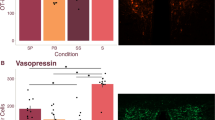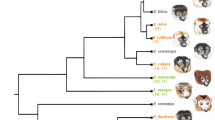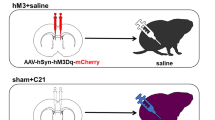Abstract
The molecular mechanisms underlying the evolution of complex behaviour are poorly understood. The mammalian genus Microtus provides an excellent model for investigating the evolution of social behaviour. Prairie voles (Microtus ochrogaster) exhibit a monogamous social structure in nature, whereas closely related meadow voles (Microtus pennsylvanicus) are solitary and polygamous1. In male prairie voles, both vasopressin and dopamine act in the ventral forebrain to regulate selective affiliation between adult mates, known as pair bond formation, as assessed by partner preference in the laboratory2,3,4. The vasopressin V1a receptor (V1aR) is expressed at higher levels in the ventral forebrain of monogamous than in promiscuous vole species5, whereas dopamine receptor distribution is relatively conserved between species. Here we substantially increase partner preference formation in the socially promiscuous meadow vole by using viral vector V1aR gene transfer into the ventral forebrain. We show that a change in the expression of a single gene in the larger context of pre-existing genetic and neural circuits can profoundly alter social behaviour, providing a potential molecular mechanism for the rapid evolution of complex social behaviour.
This is a preview of subscription content, access via your institution
Access options
Subscribe to this journal
Receive 51 print issues and online access
$199.00 per year
only $3.90 per issue
Buy this article
- Purchase on Springer Link
- Instant access to full article PDF
Prices may be subject to local taxes which are calculated during checkout




Similar content being viewed by others
References
Gruder-Adams, S. & Getz, L. L. Comparison of the mating system and paternal behavior in Microtus ochragaster and M. pennsylvanicus. J. Mamm. 66, 165–167 (1985)
Aragona, B. J., Liu, Y., Curtis, J. T., Stephan, F. K. & Wang, Z. A critical role for nucleus accumbens dopamine in partner-preference formation in male prairie voles. J. Neurosci. 23, 3483–3490 (2003)
Gingrich, B., Liu, Y., Cascio, C., Wang, Z. & Insel, T. R. Dopamine D2 receptors in the nucleus accumbens are important for social attachment in female prairie voles (Microtus ochrogaster). Behav. Neurosci. 114, 173–183 (2000)
Lim, M. M. & Young, L. J. Vasopressin-dependent neural circuits underlying pair bonding in the monogamous prairie vole. Neuroscience 125, 35–45 (2004)
Insel, T. R., Wang, Z. X. & Ferris, C. F. Patterns of brain vasopressin receptor distribution associated with social organization in microtine rodents. J. Neurosci. 14, 5381–5392 (1994)
Kleiman, D. G. Monogamy in mammals. Q. Rev. Biol. 52, 39–69 (1977)
Winslow, J. T., Hastings, N., Carter, C. S., Harbaugh, C. R. & Insel, T. R. A role for central vasopressin in pair bonding in monogamous prairie voles. Nature 365, 545–548 (1993)
Wang, Z., Ferris, C. F. & De Vries, G. J. Role of septal vasopressin innervation in paternal behavior in prairie voles (Microtus ochrogaster). Proc. Natl Acad. Sci. USA 91, 400–404 (1994)
Young, L. J., Nilsen, R., Waymire, K. G., MacGregor, G. R. & Insel, T. R. Increased affiliative response to vasopressin in mice expressing the V1a receptor from a monogamous vole. Nature 400, 766–768 (1999)
Lim, M. M., Murphy, A. Z. & Young, L. J. Ventral striatopallidal oxytocin and vasopressin V1a receptors in the monogamous prairie vole (Microtus ochrogaster). J. Comp. Neurol. 468, 555–570 (2004)
Young, L. J., Toloczko, D. & Insel, T. R. Localization of vasopressin (V1a) receptor binding and mRNA in the rhesus monkey brain. J. Neuroendocrinol. 11, 291–297 (1999)
Young, L. J. Frank A. Beach Award. Oxytocin and vasopressin receptors and species-typical social behaviors. Horm. Behav. 36, 212–221 (1999)
Wang, Z. et al. Vasopressin in the forebrain of common marmosets (Callithrix jacchus): studies with in situ hybridization, immunocytochemistry and receptor autoradiography. Brain Res. 768, 147–156 (1997)
Bester-Meredith, J. K., Young, L. J. & Marler, C. A. Species differences in paternal behavior and aggression in peromyscus and their associations with vasopressin immunoreactivity and receptors. Horm. Behav. 36, 25–38 (1999)
Parker, K. J. & Lee, T. M. Development of selective partner preferences in captive male and female meadow voles, Microtus pennsylvanicus. Anim. Behav. 61, 1217–1226 (2001)
Wang, Z. et al. Dopamine D2 receptor-mediated regulation of partner preferences in female prairie voles (Microtus ochrogaster): a mechanism for pair bonding? Behav. Neurosci. 113, 602–611 (1999)
Roberts, R. L., Williams, J. R., Wang, A. K. & Carter, C. S. Cooperative breeding and monogamy in prairie voles: influence of the sire and geographical variation. Anim. Behav. 55, 1131–1140 (1998)
Bielsky, I. F., Bao-Hu, S., Szegda, K. L., Westphal, H. & Young, L. J. Profound impairment in social recognition and reduction in anxiety-like behavior in vasopressin V1a receptor knockout mice. Neuropsychopharmacology 29, 483–493 (2004)
Landgraf, R. et al. Viral vector-mediated gene transfer of the vole V1a vasopressin receptor in the rat septum: improved social discrimination and active social behaviour. Eur. J. Neurosci. 18, 403–411 (2003)
Aragona, B. J. et al. Opposite modulation of social attachment by D1- and D2-type dopamine receptor activation in nucleus accumbens shell. Horm. Behav. 44, 37 (2003)
Robinson, G. E. & Ben-Shahar, Y. Social behavior and comparative genomics: new genes or new gene regulation? Genes Brain Behav. 1, 197–203 (2002)
Hammock, E. A. D. & Young, L. J. Functional microsatellite polymorphism associated with divergent social structure in vole species. Mol. Biol. Evol. (in the press)
Phelps, S. M. & Young, L. J. Extraordinary diversity in vasopressin (V1a) receptor distributions among wild prairie voles (Microtus ochrogaster): patterns of variation and covariation. J. Comp. Neurol. 466, 564–576 (2003)
Hammock, E. A. D. & Young, L. J. Variation in the vasopressin V1a receptor promoter and expression: implications for inter- and intraspecific variation in social behaviour. Eur. J. Neurosci. 16, 399–402 (2002)
Barberis, C. & Tribollet, E. Vasopressin and oxytocin receptors in the central nervous system. Crit. Rev. Neurobiol. 10, 119–154 (1996)
Kim, S. J. et al. Transmission disequilibrium testing of arginine vasopressin receptor 1A (AVPR1A) polymorphisms in autism. Mol. Psychiatry 7, 503–507 (2002)
Pitkow, L. J. et al. Facilitation of affiliation and pair-bond formation by vasopressin receptor gene transfer into the ventral forebrain of a monogamous vole. J. Neurosci. 21, 7392–7396 (2001)
Young, L. J., Winslow, J. T., Nilsen, R. & Insel, T. R. Species differences in V1a receptor gene expression in monogamous and nonmonogamous voles: behavioral consequences. Behav. Neurosci. 111, 599–605 (1997)
Acknowledgements
We thank C. A. Sharer for contributing to the initial viral vector work, L. Miller for assistance with meadow vole breeding, and A. Z. Murphy and E. A. D. Hammock for their critical readings of the manuscript. Funding for this work was provided by grants from the NIH to M.M.L., Z.X.W., L.J.Y. and the Yerkes Center, and by a NSF STC grant to the Center for Behavioral Neuroscience.Authors' contributions M.M.L. performed the experiments and wrote the manuscript. Z.X.W. provided the animals and behavioural testing equipment for the pilot studies, the D2 autoradiography protocol and scientific input. D.E.O. assisted with the paternal behaviour testing. X.H.R. and E.F.T. generated the viral vectors. L.J.Y. conceived the idea and co-wrote the manuscript.
Author information
Authors and Affiliations
Corresponding author
Ethics declarations
Competing interests
The authors declare that they have no competing financial interests.
Rights and permissions
About this article
Cite this article
Lim, M., Wang, Z., Olazábal, D. et al. Enhanced partner preference in a promiscuous species by manipulating the expression of a single gene. Nature 429, 754–757 (2004). https://doi.org/10.1038/nature02539
Received:
Accepted:
Issue Date:
DOI: https://doi.org/10.1038/nature02539
This article is cited by
-
Partner separation rescues pair bond-induced decreases in hypothalamic oxytocin neural densities
Scientific Reports (2023)
-
Evolution of central neural circuits: state of the art and perspectives
Nature Reviews Neuroscience (2022)
-
Distribution of vasopressin 1a and oxytocin receptor protein and mRNA in the basal forebrain and midbrain of the spiny mouse (Acomys cahirinus)
Brain Structure and Function (2022)
-
Comparative neurotranscriptomics reveal widespread species differences associated with bonding
BMC Genomics (2021)
-
Neural correlates of product attachment to cosmetics
Scientific Reports (2021)
Comments
By submitting a comment you agree to abide by our Terms and Community Guidelines. If you find something abusive or that does not comply with our terms or guidelines please flag it as inappropriate.



